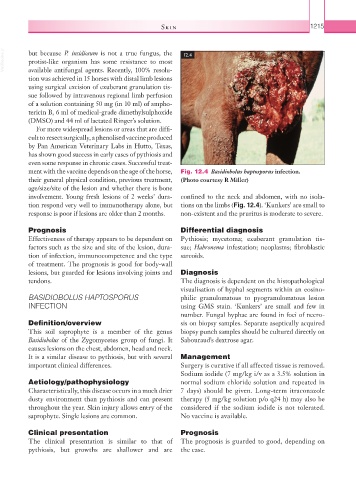Page 1240 - Equine Clinical Medicine, Surgery and Reproduction, 2nd Edition
P. 1240
Skin 1215
VetBooks.ir but because P. insidiosum is not a true fungus, the 12.4
protist-like organism has some resistance to most
available antifungal agents. Recently, 100% resolu-
tion was achieved in 15 horses with distal limb lesions
using surgical excision of exuberant granulation tis-
sue followed by intravenous regional limb perfusion
of a solution containing 50 mg (in 10 ml) of ampho-
tericin B, 6 ml of medical-grade dimethylsulphoxide
(DMSO) and 44 ml of lactated Ringer’s solution.
For more widespread lesions or areas that are diffi-
cult to resect surgically, a phenolised vaccine produced
by Pan American Veterinary Labs in Hutto, Texas,
has shown good success in early cases of pythiosis and
even some response in chronic cases. Successful treat-
ment with the vaccine depends on the age of the horse, Fig. 12.4 Basidiobolus haptosporus infection.
their general physical condition, previous treatment, (Photo courtesy R Miller)
age/size/site of the lesion and whether there is bone
involvement. Young fresh lesions of 2 weeks’ dura- confined to the neck and abdomen, with no isola-
tion respond very well to immunotherapy alone, but tions on the limbs (Fig. 12.4). ‘Kunkers’ are small to
response is poor if lesions are older than 2 months. non- existent and the pruritus is moderate to severe.
Prognosis Differential diagnosis
Effectiveness of therapy appears to be dependent on Pythiosis; mycetoma; exuberant granulation tis-
factors such as the size and site of the lesion, dura- sue; Habronema infestation; neoplasms; fibroblastic
tion of infection, immunocompetence and the type sarcoids.
of treatment. The prognosis is good for body-wall
lesions, but guarded for lesions involving joints and Diagnosis
tendons. The diagnosis is dependent on the histopathological
visualisation of hyphal segments within an eosino-
BASIDIOBOLUS HAPTOSPORUS philic granulomatous to pyogranulomatous lesion
INFECTION using GMS stain. ‘Kunkers’ are small and few in
number. Fungal hyphae are found in foci of necro-
Definition/overview sis on biopsy samples. Separate aseptically acquired
This soil saprophyte is a member of the genus biopsy punch samples should be cultured directly on
Basidiobolus of the Zygomycetes group of fungi. It Sabouraud’s dextrose agar.
causes lesions on the chest, abdomen, head and neck.
It is a similar disease to pythiosis, but with several Management
important clinical differences. Surgery is curative if all affected tissue is removed.
Sodium iodide (7 mg/kg i/v as a 3.5% solution in
Aetiology/pathophysiology normal sodium chloride solution and repeated in
Characteristically, this disease occurs in a much drier 7 days) should be given. Long-term itraconazole
dusty environment than pythiosis and can present therapy (5 mg/kg solution p/o q24 h) may also be
throughout the year. Skin injury allows entry of the considered if the sodium iodide is not tolerated.
saprophyte. Single lesions are common. No vaccine is available.
Clinical presentation Prognosis
The clinical presentation is similar to that of The prognosis is guarded to good, depending on
pythiosis, but growths are shallower and are the case.

